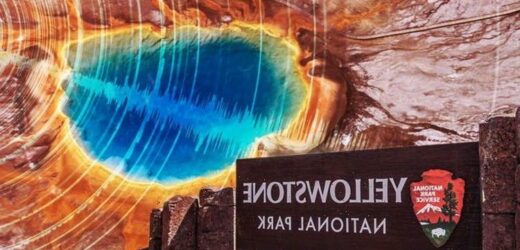Yellowstone Volcano: Super eruptions 'are very rare' says expert
We use your sign-up to provide content in ways you’ve consented to and to improve our understanding of you. This may include adverts from us and 3rd parties based on our understanding. You can unsubscribe at any time. More info
Seismic activity has risen in central Idaho in the past 20 months, prompting fears of something sinister brewing in the neighbouring Yellowstone National Park. According to the USGS, Idaho has been rocked by a series of aftershocks after a magnitude 6.5 quake struck near Stanley in late March last year. As of Monday, USGS experts have recorded more than 4,300 aftershocks, which the agency claimed “has alarmed some people”.
The USGS wrote in its weekly Caldera Chronicles column: “A common question seen after many earthquakes in western US is, ‘Will this earthquake trigger an eruption at Yellowstone?’
“Or, ‘Is this seismicity related to Yellowstone?'”
Although Yellowstone is mostly contained within the northwest corner of Wyoming, parts of the national park extend into Montana and Idaho.
And Yellowstone park is, of course, home to the Yellowstone volcano caldera – an active supervolcano many people fear is overdue for an eruption.


Geological records show Yellowstone’s most recent period of activity – lava flows – ocurred about 70,000 years ago.
And the volcano’s three biggest eruptions went off about 640,000, 1.3 million and 2.1 million years ago.
Although the USGS has assured this is not the case, the cycle of eruptions has led many to believe Yellowstone erupts like clockwork and that we are overdue for another blast.
But even if Yellowstone is not overdue and is not expected to erupt any time soon, could the Idaho seismicity 155 miles away have any impact on the volcano’s odds of blowing?
According to the USGS, the simple answer is: “No.”
Yellowstone volcano: Expert debunks theory of 'overdue' eruption
The agency said: “Aftershocks are a normal and forecastable phenomenon following tectonic earthquakes caused when the Earth’s crust moves past itself along fractures called faults.
“This movement usually happens very quickly as stored tectonics force is released.
“The energy produced by the fault movement is converted into seismic waves that radiate outward from the rupture.”
Geologists estimate faults rupture at a length of a “few 10s to 100s of kilometres” at a time.
The Stanley earthquake rupture on March 31 was measured at about 12 miles (20km) long.


This particular fault is part of the Basin and Range province, which the USGS said has no direct link to the magmatic system under Yellowstone.
The group added: “Does all this seismic activity in central Idaho affect the Yellowstone volcanic field?
“Not in any significant way. Large, distant earthquakes can cause changes to geysers and hot springs within Yellowstone because shaking fractures the fragile subsurface hot water plumbing systems.
“However, significant tectonic stresses are not transmitted very far.”
Despite these assurances, the USGS was bombarded on social media with questions about Idaho’s earthquake activity and Yellowstone volcano.
Replying to these queries, the agency once again assured there is no link between the two but revealed seismicity can be a potential sign of volcanism in Idaho itself.
The USGS wrote: “We typically see eruptions in the Craters of the Moon area every few thousands of years (most recent was about 2000 years ago).
“The last time Yellowstone erupted (which was a lava flow) was 70,000 years ago.
“So, yes, the odds are extremely good that Idaho will experience numerous eruptions before anything happens at Yellowstone.”
Source: Read Full Article


